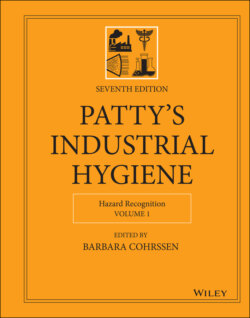Читать книгу Patty's Industrial Hygiene, Hazard Recognition - Группа авторов - Страница 40
5 Industrial Hygiene Today: Currently Defining Occupational and Industrial Hygiene
ОглавлениеGiven the developments and evolution of the practice of industrial hygiene over time, it is informative to take the available information on the history and current and emerging practice of industrial hygiene and consider the current definition of the scope of practice for occupational and industrial hygiene.
There are multiple definitions of Occupational and Industrial Hygiene but the most commonly quoted are found below.
The AIHA defines industrial hygiene as the “…science and practice devoted to the anticipation, recognition, evaluation, and control of those environmental factors or stresses, arising in or from the workplace, that may cause sickness, impaired health and well‐being, or significant discomfort among workers or among citizens of the community” (https://www.aiha.org/about-ih/Pages/default.aspx).
The ABIH that administers IH certification programs defines industrial hygiene as: “the science of protecting and enhancing the health and safety of people at work and in their communities” (http://abih.org/content/ih-defined).
FIGURE 3 British Occupational Hygiene Society workplace health triangle.
The IOHA defines occupational hygiene as: “the discipline of anticipating, recognizing, evaluating and controlling health hazards in the working environment with the objective of protecting worker health and well‐being and safeguarding the community at large” (https://ioha.net/faq).
By any definition, however, industrial hygiene is an applied science encompassing the application of knowledge from a multidisciplinary profession, including the sciences and professions of chemistry, engineering, biology, mathematics, medicine, physics, toxicology, and other specialties. Industrial hygiene meets the criteria for the definition as a science since it brings together in context and practice an organized body of knowledge necessary for the anticipation, recognition, evaluation, and control of health stresses in the work environment.
It is clear that occupational hygienists often have to have established links to the occupational medicine aspects of their organizations. This includes physicians, occupational nurses, and others who treat work‐related injuries and illness or who may be involved in return to work program or workplace accommodation decisions or other work‐related matters. This relationship and others are illustrated in the figure below which was developed by the British Occupational Hygiene Association. (https://app.croneri.co.uk/feature-articles/navigating-workplace-health-triangle) (see Figure 3). Figure 3 also demonstrates the increased emphasis and understanding of TWH and ensuring the health of workers within the context of their full lives, not just their livelihood.
